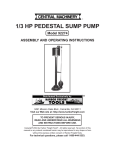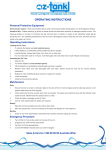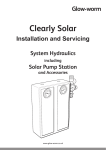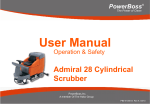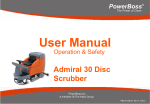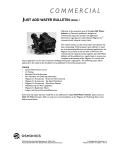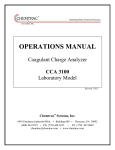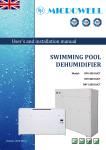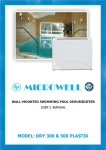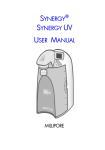Download See the operation and service manual for this model
Transcript
OPERATION AND MAINTENANCE MANUAL WRS MODELS WATER RECYCLE SYSTEM CASCADE ENGINEERING INC P.O. BOX 6218 COLORADO SPRINGS, COLORADO 80934 TABLE OF CONTENTS UNIT DESCRIPTION page 3 SYSTEM DESCRIPTION 4 TYPICAL FLOW DIAGRAM 5 SPECIFICATIONS 6 RECYCLE SYSTEM LAYOUT AND CONNECTIONS 7 INSTALLATION AND STARTUP 8 OPERATION 12 INITIAL SETTINGS OF TIMERS AND REAGENTS PUMPS 14 REAGENT PUMPS SETTINGS 15 MAINTENANCE 16 TROUBLESHOOTING GUIDE 19 ELECTRICAL SCHEMATICS 22 PIPING SCHEMATIC 23 RECOMMENDED SPARE PARTS 24 PARTS LISTING 25 PARTS LOCATING DRAWING 27 DAILY LOG SHEET FORM 28 SETTINGS LOG SHEET FORM 29 SPECIAL OPTIONS INFORMATION 30 COMPONENTS MANUALS 2 SYSTEM DESCRIPTION The WRS Water Recycle Systems are compact wastewater treatment systems designed specifically for recycling wash water. They will treat wash water and allow it to be reused in the washing operation. The Recycle Systems are also applicable to a number of other industrial wastewater recycling requirements. The Recycle Systems operate completely automatically to treat the water and maintain a supply for washing. Make up water is automatically added as required to replace that lost to evaporation. The Recycle Systems add reagents to the water to remove most of the contaminants and provide excellent quality treated water. The pH of the water is automatically measured and a pH adjusting reagent is added to neutralize the water. This makes the water safer for those who may come in contact with it and allows the other treatment reagents to do their job more effectively. An oxidizer is added to disinfect and deodorize the water. The oxidizer is added in an amount that will effectively control objectionable odors. One of a series of water treatment polymers, known as “coagulants”, is added to the water to remove most of the pollutants that come from the washing operation. All of these reagents are added to the water to improve its quality and make it more “user friendly”. They counteract the pollutants in the water, which may be hazardous, and make it safe and comfortable to use. The pH adjuster and the coagulant are added to the wastewater as it enters the recycle unit. A pH sensor measures the pH and adds the reagent in the amount required to maintain the pH at 7, or neutral. In the first tank, the coagulant forms “floc particles” with the pollutants that grow as the water gently moves through the tank. It then flows to the second tank, the separator tank. This tank is constructed so that the water is very calm. The particles are normally heavy and will settle to the bottom. The treated water then flows to the storage tank, where it is held until it is needed for reuse in the washing operation. The oxidizer is added to the water as it enters the storage tank to insure that it is free of odor and bacteria. The discharge pump pressurizes the water to feed the pressure washer and forces it through a final polishing filter, which insures that no objectionable particles are carried along. The floc particles settle out as sludge in the bottom of the separator tank, and to some extent in the coagulant tank. An automatic sludge removal system periodically transfers the sludge to a set of sludge socks, which are located in a compartment at the right end of the machine. Some of the pollutants will float in the coagulant and separator tanks. An automatic skimming system, similar to the sludge system, periodically removes the floating scum and transfers it to the same sludge socks. The sludge socks and the final cartridge filters are replaced when they are full. The control panel of the recycle includes lighted switches that give an indication of the status of the machine operation. Some indications are verification that power is on, whether wastewater is flowing into the machine, whether the reagent pumps are 4 WRS MODELS WATER RECYCLE SYSTEM SPECIFICATIONS Rated flow rate: WRS 12+ 2 gpm; WRS 32 8 gpm; WRS 42 12 gpm; WRS 52 16 gpm Electrical requirement: 115 VAC, 60 Hz, 1 phase, 15 amp total Recycle feed pump: Self priming centrifugal cast iron pump with 1/2 HP motor. Mounted on machine base. Controlled by float switch in collection pit. Suction line strainer and foot valve are provided. Discharge pump: High head centrifugal pump with 1/2 HP thermally protected motor. Provides pressurized water flow to pressure washer and other uses. Electrical controls: GFCI provided, prewired with 15 amp plug, 10 ft cord Lighted switches for power, feed pump, coagulant pump, oxidizer pump, pH adjuster pump, makeup water, and manual drain. PH controller with digital display. NEMA 4 rated enclosure Reagent metering pumps: Electronic controlled diaphragm pumps with stroke rate and stroke length controls and manual bleed valve for ease of priming. Three pumps are supplied, for coagulant, oxidizer, and pH adjuster. Pumps are mounted in a fiberglass enclosure. Inlet strainer: Large size with stainless steel screen in corrosion resistant plastic housing. Filter system: Two 20” long 25 micron filter cartridges final polishing (WRS 12+ one filter). Sludge collection system: Large, disposable fabric socks collect sludge. Two sets supplied with machine. Make up water: 4 to 16 gpm as required for application. 100 psi maximum pressure. Recycle tank capacities: Coagulant tank 50; 120; 150; 180 gallons Separator tank 50; 120; 180; 240 gallons Storage tank 50; 120; 150; 150 gallons Total water capacity - 150; 360; 480; 570 gallons Recycle construction: Heavy duty polypropylene tank with unitized construction. Schedule 80 PVC pipe used throughout. Heavy galvanized steel base assembly. Connection sizes: Machine inlet- 1 1/2 NPT (WRS 12+ 1 NPT). Treated water outlet- 3/4 NPT Drain line- 1 NPT Make up water- 1/2 NPT Overall dimensions: WRS 12+: 5 ft 1 in long, 2 ft 5 in deep, 4 ft 3 in tall WRS 32: 7 ft 6 in long, 3 ft 2 in deep, 4 ft 3 in tall WRS 42: 8 ft 0 in long, 3 ft 8 in deep, 4 ft 3 in tall WRS 52: 8 ft 0 in long, 4 ft 2 in deep, 4 ft 3 in tall Shipping weight: WRS 12+ 400 lb; WRS 32 800 lb; WRS 42 900 lb; WRS 52 950 lb Options: Second pH adjusting pump. Additional treated water storage capacity. Activated carbon water polishing systems. Ozone treatment. Pretreatment systems, oil skimmers, and oily water separators. Graduated reagent containers. Custom modifications available. 6 INSTALLATION AND STARTUP The WRS Recycle System is shipped virtually completely assembled and tested from the factory. All electrical wiring is complete and a 15 amp Ground Fault Current Interrupter device and plug are included. A 15 amp, 115 volt electrical supply is required (use 20 amp breaker). Required plumbing connections are an inlet line from the collection pit, a drain line from the recycle to the pit, the treated water outlet to the pressure washer, and the make up water line to the recycle. There should not be a connection to a sewer line or other discharge. The WRS Systems are designed for closed loop operation. If at any time water needs to be disposed of, it must be in a legally accepted manner. Consult authorities in your area for an acceptable procedure. The reagent pumps are completely installed, including suction lines that are to be placed in the reagent storage drums. The inlet strainer, cartridge filters, and sludge socks are installed and ready to operate. INSTALLATION CHECKLIST Following is a checklist of the major items necessary to install and startup the WRS Recycle System. Be sure to observe the detailed instructions which follow: 1) Install leveling lugs, position and level the recycle in the desired position. The machine may be placed directly against a wall. 2) Install the separator tank inlet assembly in the separator tank and the discharge pressure tank in the fitting on top of the discharge pump. Install the filter housings. 3) Connect the suction line from the pit to the feed pump, the drain line to the pit, the makeup water line to the makeup valve, and the discharge line to your pressure washer. 4) Start filling the recycle system with clean water. Close the two ball valves (red handles) located behind the discharge pump. These are used only for draining the machine. Do not turn the machine on until there is at least 6 inches of water in the storage tank. The discharge pump will come on when power is applied. The discharge pump must not be run dry, or damage will result. Check for leaks in piping. It is not unusual for leaks to develop in transit. Tighten fittings or repair any leaks found. 5) Install the float switch in the collection pit. Position the float at least one to two feet off the bottom. 6) Prime the feed pump by removing plug on top and filling chamber with water. 7) Plug the power cord into a 15 amp, 115 volt outlet. 8) Position the reagent drums, install pump suction tubes in the drums, and prime the reagent pumps. Set pumps as suggested on pages 14 and 15. 9) After the coagulant tank is full of water, remove the cap from the pH sensor and install the sensor in the holder provided at the top of the coagulant tank. The pH sensor must not be allowed to dry out. If it dries out, it will be ruined within a few hours. Replacement due to drying out is not covered by the warranty. 8 INSTALLATION DETAILS The Recycle System should be positioned in a location that is convenient for the operator to provide the necessary servicing. It may be placed directly against a wall. Leveling lugs are provided (in the parts box) to compensate for irregular floors. Install the lugs and adjust so that each carries some of the load. The machine should be reasonably level. The separator tank inlet well and the discharge pump pressure reservoir have been removed to prevent damage during transit. Reinstall the inlet well assembly by inserting the PVC pipe into the fitting in the center of the compartment. The connection does not need to be glued in place. To install the discharge pump reservoir, apply pipe dope to the threads and screw the reservoir into the female pipe thread fitting above the discharge pump. Tighten the connection sufficiently to prevent leaking. The inlet strainer and sludge socks are installed and ready to operate. Install the cartridge filter housings with filters to the filter heads at the right end of the recycle system. Be sure the O ring of each housing is properly installed. Connect the suction line from the waste water collection pit to the feed pump inlet, the drain line from the sludge socks tank to the pit, the fresh water makeup water line to the connection at the makeup solenoid valve, and the treated water outlet to the pressure washer and any other uses. Recommended minimum sizes for the lines are: Suction line1 1/2 inch (1 inch for WRS 12+), drain line- 1 inch, make up water- 1/2 inch, and treated water outlet- 3/4 inch. If lines are longer than approximately 50 feet, larger sizes may be required. Contact your dealer for recommendations. Be sure to install the foot valve provided at the bottom of the suction line in the collection pit. Also install the pit low level float switch in the pit. The switch has a cord approximately 30 feet long. If the pit is within this distance, utilize the cord as provided. If the pit is further away, the cord will need to be lengthened using 14 gage or heavier wire. The float switch should be positioned at least one or two feet off the bottom of the pit. The best position is to be elevated one third to one half the depth of the pit. This allows the pit to retain a quantity of water to maintain more consistent waste water, and provide volume for the heavy solids to settle. The bottom of the suction line should be positioned just below the float switch. 9 Close the two ball valves (red or black handles) located behind the discharge pump. These are used only for draining the machine. Do not turn the machine on until there is at least 6 inches water in the storage tank. It is desirable to fill the coagulant, separator and storage tanks on the machine with clean water prior to startup. By doing this, the waste water will be properly balanced with the reagents when it enters, providing better initial treatment. The feed pump will need to be primed by filling the reservoir through the plug on top. The reagent pumps are completely installed, including suction lines that are to be placed in the reagent storage drums. The reagents storage drums should be placed as close to the reagent pumps as is feasible, to insure best pump performance. The ideal location is just to the left of the recycle. The total length of tubing provided for each pump is twenty feet. If the tubing is not long enough, try to position the drums closer to the recycle. If this is not possible, longer tubing will be needed and the pump may be difficult to keep primed. If the tubing provided is longer than necessary, it will be helpful to cut off the excess amount. Place each of the three lines in the appropriate reagent drum. The 3/4 npt cord grip provided on each line is intended to be installed in a mating fitting at the drum entrance. Most drums have at least one bung with a 3/4 npt fitting. If one is not provided, simply drill a 3/8 diameter hole in a bung and feed the tubing through the hole. Be sure to reinstall the suction strainer on the end of the tubing. Adjust the tubing length inside the drum so that the suction strainer will reach the bottom of the drum. After the Recycle has been filled with clean water, turn the power switch on and observe operation. The indicator light on the switch will light if power is being supplied to the machine. The discharge pump will start when power is applied, pumping water from the storage tank to your pressure washer. The discharge pump must not be run dry. If the washer is not connected, turn the valve at the discharge connection (at the right of the discharge filters) to the off position. Turn the valve back to the on position when you are ready to use water. Check for leaks in piping. It is not unusual for leaks to develop in transit. Tighten fittings or repair any leaks found. If the pit has a sufficient quantity of water, the feed pump will operate. As soon as it removes all of the air in the incoming line, waste water will enter the coagulant tank. If the suction line from the collection pit is long, it may take more time for the pump to prime, or it may be necessary to fill the entire line with water to get it to prime. The rate the water flows through the Recycle System for treatment is controlled by the brass ball valve in the inlet piping. You will get the best possible treatment by setting the flow at the lowest rate that provides enough water for your needs. Adjust the valve to an intermediate flow rate for startup and observe the volume of treated water available compared to your usage. If there is plenty of water available, leave the flow as set, or reduce it. Whenever the flow rate is changed by adjusting the valve, the reagent pumps settings should be checked to be sure they provide the desired amounts of reagent. The coagulant pump and oxidizer pump will need to be set to the flow rate. The pH adjusting pump setting is less critical, as it is controlled by the pH controller that will compensate as long as the pump setting is not too low. Suggested pump settings for various flow rates are given on pages 14 and 15. 10 The reagent pumps have been primed at the factory, but some air will have entered the suction lines in transit. To remove air from the lines, manually hold the pump switch in the ON position and set both pump control knobs to the maximum setting. The pump will automatically move the air bubbles through the suction line and the pump. As soon as all air bubbles are purged, set the pump to the desired initial setting. See the manual section on reagents pumps settings. Repeat this procedure for each pump. When water starts flowing into the coagulant tank, the flow switch will automatically actuate the reagent pumps and treatment of the wastewater will begin. Be sure the reagent pumps have been set to the proper settings. Excessively high reagent dosages are detrimental to the treatment process, waste reagents, and can make the water difficult to treat. Whenever setting the reagent pumps, it is best to error on the low side rather than introduce too much of a reagent. The pH controller has been calibrated to the pH sensor at the factory, but it is recommended that the calibration be checked at startup and at monthly intervals thereafter. This simple procedure is explained in the maintenance section. The protective cap shipped on the pH sensor is to be removed when the recycle is ready to operate and full of water. Remove the cap and place the sensor in its receptacle in the coagulant tank. It is very important to keep the pH sensor wet at all times. Failure to do so will result in failure of the sensor within a short time, and is not covered by the warranty. If the Recycle System is drained for any reason, fill the cap with water and place it over the end of the pH sensor bulb, or place the sensor end in a container of water. Be sure to replace the sensor back in its proper location when the recycle system is restarted. Accessories or special options may require additional installation steps or changes in this installation procedure. Check the instructions at the end of the manual if any special accessories are included on your recycle system. Your recycle system is now operational. You may not obtain the best performance at startup. It is not unusual to require a few days to” fine tune” the reagents pumps settings and for the waste water to stabilize. Your dealer will work with you to arrive at the best performance possible and the recycle system should be producing the best quality treated water in a short time. 11 OPERATION Your WRS Recycle System operates completely automatically, treating wastewater as it is created, and adding fresh makeup water when needed. If wastewater is available to treat in the collection pit, and if the treated water tank is not full, the feed pump will come on and pump water to the Recycle System. When waste water is entering the machine, the flow switch senses the flow and directs the reagents pumps to operate and the skim and sludge removal timers to operate those functions. The coagulant pump and oxidizer pump run whenever flow is sensed. The pH adjust pump is controlled by the pH controller and runs only if there is flow and if the pH is not within the desired range. If the pH is above the set point of 7.0, the controller will turn the pH adjust pump on and introduce the reagent. When the pH drops below approximately 6.9, the controller will turn the pump off. The pH indicated on the display should be approximately 7. It may change somewhat if the recycle has been idle for a period of time, but should quickly return to about 7 when the recycle starts operating. A range of 6.5 to 7.5 is normally satisfactory for the pH reading. The discharge pump operates whenever the Recycle System is turned on. The pump will create up to 40 psi pressure, depending on the amount of water being used. If there is no water usage, the pressure switch will shutdown the pump. As soon as water usage begins, the pressure will drop, actuating the pressure switch and turning the pump on. When the supply of water in the collection pit drops due to evaporation and carryoff, the water level in the treated water tank will fall. As the level reaches the low float switch, the makeup valve will open and raise the level several inches until the switch is deactivated. Makeup water will be added until there is sufficient water in the collection pit to resume the treatment process. A routine daily inspection is necessary to insure that all operating systems are in order, that filters are serviceable, and that there is an adequate supply of reagents available. It is very important that this daily inspection be performed to prevent malfunctions from creating a major upset of the treatment process. The daily operation instructions that follow are also printed on the control panel of your Recycle System. A blank “Daily Log Sheet” is provided, at the rear of this manual. It is highly recommended that this log sheet be completed daily, at the same time each day. The log sheet is set up for a one month period of operation. Make copies of the blank sheet and keep them on a clip board or in a file folder, readily accessible for use. Keep a file of the completed monthly log sheets for records of reagents usage and parts replacement, and for reference by your serviceman when maintenance is required. A blank “Settings Log Sheet” is also provided. This sheet is to be filled out only when reagent pump settings or control timers are adjusted, and is not to be completed daily. If it becomes routine to fill the daily log out , say first thing in the morning, the task will not be neglected and the Recycle System will likely operate with a minimum of systems upsets. The daily inspection and filling out the log sheet takes only a few minutes if all items are functioning properly. Even if some service is required, such as replacing the filter cartridges or cleaning the inlet strainer, only a few more minutes is required. The time spent here will be more than compensated for by improved Recycle System operation and top quality treated water. 12 DAILY OPERATION INSTRUCTIONS CHECK THE FOLLOWING ITEMS ON A DAILY SCHEDULE AND RECORD ON THE DAILY LOG SHEET FOR FUTURE REFERENCE. REGULAR DAILY MAINTENANCE WILL REDUCE THE LIKELIHOOD OF SYSTEM UPSETS AND MORE EXTENSIVE MAINTENANCE REQUIREMENTS. --- CHECK THAT THE POWER TO THE RECYCLE SYSTEM IS ON. THIS IS SHOWN BY THE INDICATOR LIGHT IN THE POWER SWITCH. IF THE INDICATOR IS NOT LIGHTED, MOVE THE SWITCH TO ON OR CHECK THE POWER SUPPLY. --- CHECK THAT THE pH READING IS APPROXIMATELY 7 (BETWEEN 6.5 AND 7.5). IF THE READING IS NOT IN THE DESIRED RANGE, CHECK THE REAGENT SUPPLY AND CHECK TO BE SURE THE pH ADJUST PUMP HAS NOT LOST PRIME. REPRIME THE PUMP IF NECESSARY. ---CHECK THAT THE INLET STRAINER IS NOT PLUGGED. THIS IS INDICATED BY REDUCED FLOW INTO THE RECYCLE SYSTEM, AT THE COAGULANT TANK. IF THE FLOW LOOKS TO BE DECREASED, TURN THE VALVE IN THE HEAD OF THE STRAINER TO THE OFF POSITION, REMOVE THE STRAINER BODY, CLEAN THE ELEMENT, AND REPLACE. TURN THE VALVE IN THE HEAD BACK ON. ---CHECK THAT THE FINAL FILTERS ARE IN SERVICEABLE CONDITION. THIS IS INDICATED BY THE PRESSURE GAGE LOCATED ABOVE THE FILTERS. THE PRESSURE SHOULD BE 30 TO 50 PSI, EVEN WHILE WATER IS BEING USED. LOW PRESSURE INDICATES THAT THE FILTERS ARE BECOMING CLOGGED AND THE WATER SUPPLY TO YOUR PRESSURE WASHERS MAY NOT BE SUFFICIENT. REPLACE THE FILTERS WHEN THE PRESSURE DROPS OR A SHORTAGE OF WATER IS NOTED. ALWAYS DISPOSE OF USED FILTERS PROPERLY. ---CHECK THAT THE SLUDGE SOCKS ARE NOT FULL. THIS IS INDICATED BY WATER FLOWING OUT THE TOP OF THE RELIEF TUBE ABOVE THE SOCKS. IF A SIGNIFICANT AMOUNT OF WATER FLOWS OUT DURING OPERATION, THE SOCKS SHOULD BE REPLACED. ALLOW THE SOCKS TO DRAIN AND DRY OUT. ALWAYS DISPOSE OF USED SLUDGE SOCKS PROPERLY. ---CHECK THE SUPPLY OF REAGENTS. IF A CONTAINER IS NEAR EMPTY, REPLACE OR REFILL IT. ALWAYS WEAR GLOVES AND EYE PROTECTION WHEN HANDLING THE REAGENTS. CHECK THE MATERIAL SAFETY DATA SHEETS FOR ADDITIONAL PRECAUTIONS. ---CHECK THAT THE WATER QUALITY IS ADEQUATE FOR USE. THE CLARITY OF THE WATER MAY VARY FROM TIME TO TIME, BUT IT SHOULD ALWAYS BE REASONABLY CLEAR. IF IT IS CLOUDY OR AN OBJECTIONABLE ODOR IS PRESENT, CHECK THE REAGENT PUMPS TO BE SURE THEY ARE PUMPING . REPRIME IF NECESSARY. CHECK THE OPERATION AND MAINTENANCE MANUAL FOR FURTHER INFORMATION ON RESOLVING TREATMENT PROBLEMS. ---DRAIN A SMALL AMOUNT OF WATER OUT OF THE STORAGE TANK TO PURGE SETTLED SOLIDS FROM THE BOTTOM OF THE TANK. OPEN THE BALL VALVE BELOW THE FINAL FILTERS TO DRAIN WATER BACK TO YOUR SETTLING PIT. APPROXIMATELY 1 MINUTE IS USUALLY SUFFICIENT. CLOSE THE VALVE TO RESUME NORMAL OPERATION. CONSULT YOUR OPERATION AND MAINTENANCE MANUAL FOR OTHER PERIODIC MAINTENANCE AND FOR ADDITIONAL OPERATING INSTRUCTIONS. CONTACT YOUR DEALER IF SERVICE PARTS OR REPAIRS ARE REQUIRED. 13 INITIAL SETTINGS OF TIMERS AND REAGENTS PUMPS Suggested initial settings for the process control timers are as follows: Skim timer-30 seconds. The skim timer actuates the skim tubes in the coagulant and separator tanks, to remove floating solids from the tanks surface. If there are excess solids on the surface, increase the setting. The skim timer is the left most of the three adjustable timers. This cycle occurs first, whenever flow starts into the recycle. Sludge removal timer- 30 seconds. The sludge removal timer actuates the sludge valves at the bottom of the coagulant and separator tanks, to remove settled solids from the tanks. If there are excess solids in the tanks, increase the setting. The sludge removal timer is the center of the three adjustable timers. This cycle follows the skim cycle. Delay timer- 300 seconds. The delay timer simply causes a delay after the sludge removal cycle before the next skim cycle starts. This cycle is normally left set at the maximum setting, 300 seconds. The delay timer is the right most of the three adjustable timers. Suggested initial settings of the reagents pumps are as follows. The reagent pumps are located in the pumps enclosure near the center of the recycle. While these are good initial settings, your operating conditions may require other settings. Your dealer will assist your in setting each reagent pump to obtain the best operation. Be sure to record the pump settings on the settings chart whenever they are changed: Coagulant pump- 500 ppm or as recommended. Set the pump for your water flow rate, per the chart that follows. Set the small speed knob to the first number given, set the large stroke knob to the second setting given. Oxidizer pump- 500 ppm. Set the pump for your water flow rate, per the chart that follows. Set the small speed knob to the first number given, set the large stroke knob to the second setting given. Use only the required amount of oxidizer to control odor, especially if chlorine (bleach or sodium hypochlorite) is used as the oxidizer. CAUTION- AN EXCESSIVELY HIGH AMOUNT OF CHLORINE, OR BLEACH, (SODIUM HYPOCHLORITE, SOMETIMES USED AS THE OXIDIZER) IS UNNECESSARY AND CAN DAMAGE EQUIPMENT, INCLUDING THE HOLDING TANKS. IF CHLORINE ODOR IS PRESENT IN THE TREATED WATER, REDUCE PUMP SETTING. PH adjust pump- 2000 ppm. Set the pump for your water flow rate, per the chart that follows. Set the small speed knob to the first number given, set the large stroke knob to the second setting given. The pH adjust pump is controlled by the pH controller and runs only when the controller actuates it. 14 REAGENT PUMPS SETTINGS The following charts give the pump speed setting and the pump stroke setting required to yield desired reagent dosage rates. In general it is best to keep the stroke at as high a value as possible and reduce the speed to reduce dosage. When the speed setting drops to 10%, it is necessary to reduce the stroke length. These criteria are reflected in the settings given below. To use the charts, first determine the maximum capacity of the pump being set. The maximum capacity, either 12 or 30 gpd, will be printed on the faceplate of the pump. Using the chart for the correct pump size, find the column with the water flow rate your recycle is operating at, such as 6 gpm. Then follow down the column until you reach the desired dosage rate in parts per million (ppm). Set the small knob on the pump to the speed setting given, and set the large knob on the pump to the stroke setting given. Adjust the large stroke length knob only when the pump is operating. If water is not flowing into the recycle and the pump is not running (as indicated by the light in the pump switch), push the switch to the manual “on” position and the light will come on. Adjust the large knob while holding the switch in the manual on position. The switch will return to the “auto” position when it is released. The small speed setting knob may be adjusted at any time, it is not necessary for the pump to be running. REAGENT PUMP SETTINGS FOR 12 GPD PUMPS SET THE PUMP SPEED AND STROKE KNOBS AS SHOWN BELOW FOR YOUR WATER FLOW RATE PPM 100 200 300 400 500 600 800 1000 1500 2000 2 GPM 10 25 10 50 10 75 10 100 12 100 15 100 20 100 25 100 35 100 50 100 3 GPM 10 45 10 90 11 100 16 100 20 100 25 100 30 100 35 100 50 100 70 100 10 10 15 20 25 30 40 50 70 95 4 GPM 100 100 100 100 100 100 100 100 100 100 10 12 20 25 30 35 50 60 90 100 5 GPM 100 100 100 100 100 100 100 100 100 100 10 15 20 30 35 45 60 70 100 6 GPM 70 100 100 100 100 100 100 100 100 10 20 30 40 50 60 80 100 8 GPM 100 100 100 100 100 100 100 100 12 25 35 50 60 70 100 10 GPM 100 100 100 100 100 100 100 15 30 45 60 70 90 12 GPM 100 100 100 100 100 100 REAGENT PUMP SETTINGS FOR 30 GPD PUMPS SET THE PUMP SPEED AND STROKE KNOBS AS SHOWN BELOW FOR YOUR WATER FLOW RATE PPM 100 200 300 400 500 600 800 1000 1500 2000 10 10 10 10 10 10 10 10 13 20 2 GPM 10 20 30 35 45 55 70 90 100 100 10 10 10 10 10 10 12 15 20 30 3 GPM 15 30 40 60 70 80 100 100 100 100 4 GPM 10 20 10 40 10 60 10 80 10 100 12 100 15 100 20 100 30 100 40 100 10 10 10 10 12 15 20 25 35 50 5 GPM 25 50 75 100 100 100 100 100 100 100 10 10 10 12 15 20 25 30 45 60 15 6 GPM 30 10 60 10 90 12 100 15 100 20 100 25 100 30 100 40 100 60 100 75 40 80 100 100 100 100 100 100 100 100 8 GPM 10 10 15 20 25 30 40 50 75 100 10 GPM 50 10 100 12 100 20 100 25 100 30 100 35 100 50 100 60 100 90 100 12 GPM 60 100 100 100 100 100 100 100 100 MAINTENANCE Your Recycle System operates automatically, but it does require regular servicing to maintain proper performance. Performing the servicing items which follow will insure that the Recycle system will usually perform at its best. It will also occasionally require some repairs or parts replacement. Many routine repairs may be performed by your personnel if desired. Information provided in this section and in the component manufacturers information in the appendices will be helpful in resolving problems which may occur. If you have difficulty or do not wish to do your own repairs, your dealer is knowledgeable and is equipped to handle any repairs or parts replacement which may be required. DAILY MAINTENANCE The regular daily maintenance consists of the daily operation inspection described in the operation section. Be sure to fill out the “Daily Log Sheet” each day and keep completed log sheets in a file. The information on the daily log will often be helpful to the serviceman. If any problems are noted in the daily inspection, they should be corrected as soon as possible to prevent major upsets of the recycle system. The best insurance against problems is a good routine maintenance program. WEEKLY MAINTENANCE It is recommended that a thorough inspection be made of the complete recycle system once a week. Check over the entire system, including peripheral equipment to be sure it is operating properly. Check the reagent pumps to be sure they are pumping. This is best done by observing the discharge line at the pump. When the pump strokes (every 1 to 6 seconds, depending on the speed setting) the discharge line will pulse, moving slightly. You may also be able to see the fluid move if there is an air bubble in the line. If the line does not pulse when the pump strokes, the pump is not pumping and is likely airlocked. To remove air from the line, simply increase the pump settings to the maximum and allow the pump to expel the air. As soon as fluid starts flowing, return the pump settings to their original values to resume normal operation. Check the skimming system to be sure it is set to keep the tanks surface fairly clear. If there is an excess amount of scum on the surface, first check that the skimming pipes are set so the water level is about half way up the tapered end of each pipe when water is flowing into the recycle. (Note that the water level drops slightly when flow stops. Adjust the skimming pipes only when water is flowing in.) If the pipes are set properly and not enough scum is being removed, increase the skim timer setting. The skim timer is located in the control box, and is the left of the three timers. Increase the skim timer setting to provide more skimming. If the tanks surface is completely clear of floating scum, the timer may be set too high. An excess amount of skim time decreases the amount of water 16 flowing to the treated water tank and will interfere with the best treatment. Reduce the timer setting if the surface is completely clear. Be sure to record the new timer setting on the “Settings Log Sheet” for future reference. It should not be necessary to adjust the timer very often once the recycle system as been set up and operation has stabilized. Check the sludge removal system to be sure it is set to keep excess sludge from accumulating in the bottom of the coagulant and separator tanks. If too much sludge accumulates, it can rise up to the treated water outlet and carry over to the treated water tank. It can also create an odor problem if it becomes septic in the tank. The best method to determine if enough sludge is being removed and collected in the sludge socks is to use a 5 foot length of clear tubing (3/4 to 1 inch diameter is best) to take a sample from the tank. Insert the tube in the separator compartment to the bottom. Plug the top of the tube and lift the tube up vertically. Stop just before the bottom of the tube comes out of the tank and observe the water in the tube. Near the bottom of the tube, the water will be darker in color and heavier, containing the settled sludge. The dark color should extend up the tube about a foot. If it is deeper, increase the sludge removal timer setting. If it is much less or there is no sludge, decrease the timer setting. The sludge removal timer is located in the control box and is the center of the three timers. An excess amount of sludge removal time decreases the amount of water flowing to the treated water tank and will interfere with the best treatment. Reduce the timer setting if there is little sludge in the tube. Be sure to record the new timer setting on the “Settings Log Sheet” for future reference. It should not be necessary to adjust the timer very often once the recycle system has been set up and operation has stabilized. MONTHLY MAINTENANCE Calibration of the pH sensor is recommended at initial startup and monthly thereafter. It also is wise to check the calibration anytime it is suspected the pH reading may not be accurate. First clean the sensor bulb gently with soapy water and rinse, then Calibrate the pH sensor to the controller by the following procedure: 1) Mix a pH 7.0 buffer solution. Dissolve the contents of one yellow buffer powder packet in 50 ml (approximately 2 ounces) of distilled water in a clean container. Also mix a pH 4.01 buffer solution by dissolving the contents of one red buffer powder packet in 50 ml of distilled water in another clean container. 2) Immerse the pH sensor in the yellow 7.0 buffer solution and allow the reading on the pH controller to stabilize. Turn the small “calibrate” screw on the upper, right front of the controller until the display reads 7.0. Rinse the pH sensor in clean water. 3) Immerse the pH sensor in the red 4.01 buffer solution and allow the reading on the pH controller to stabilize. Turn the small “slope” screw on the lower, right front of the controller until the display reads 4.0. Calibration is now complete. 17 If either screw will not turn enough to allow calibration, either the pH sensor or the controller is defective and will need to be replaced. If the controller reacts very slowly to change in pH, it is most likely that the pH sensor is either in need of cleaning or is nearing the end of its life. Clean the bulb end of the sensor gently with soapy water. If the controller is still very slow reacting, the sensor will need to be replaced. The sensor and controller are normally very accurate and require little adjustment. It is very important to keep the pH sensor wet at all times. Failure to do so will result in failure of the sensor within a few hours, and is not covered by the warranty. If the Recycle System is drained for any reason, fill the cap with water and place it over the end of the pH sensor bulb, or place the sensor end in a container of water. Be sure to replace the sensor back in its proper location when the Recycle System is restarted. CLEANING OUT COLLECTION PIT The collection pit serves two purposes. One purpose is to provide a reservoir for the wastewater to allow it to mix and be of relatively uniform composition. This minimizes changes in the treatment process even when changes are made in the washing operation. The other important function of the collection pit is to remove the heavier solids and floatable oils and greases from the wastewater before they reach the Recycle system. It is more economical to dispose of the heavy solids and oils and greases before they reach the recycle. A properly designed pit will remove a great deal of these items and result in better treatment quality, use of less reagent, and use of fewer filter cartridges and sludge socks. The collection pit will need to be cleaned out periodically. All material removed, including water, solids, oils, and greases, must be disposed of properly. The interval between required cleanings varies greatly and depends on your pit design and size, what you are washing, and how much washing you do. Small pits may need to be cleaned out several times per year, larger ones less frequently. If the pit is allowed to become filled with solids and oils, your system will operate as if it had no pit system and treatment quality will suffer. DRAINING THE RECYCLE Your Recycle System may need to be drained for maintenance or for periods of shutdown. Provision is made on the recycle to easily drain all compartments. To drain the entire machine, turn the power switch to off, turn the manual drain switch to on, and open the two ball valves (red or black handles) located behind the discharge pump at the lower, right end of the machine. All compartments will drain out the drain line and back to the pit. After the machine is drained, turn the manual drain switch to the off position. Be sure the pH probe is kept wet as described in the installation section. To return the Recycle System to operation, close the two ball valves and turn the power switch to the on position. Be sure the manual drain switch is off. It is usually best to start up with clean water in the recycle tanks, as described in the start up instructions. Also follow all other start up instructions. 18 TROUBLESHOOTING GUIDE The water clarity produced by your Recycle System may vary from time to time, but it should always be fairly clear, odor free, and pleasant to use. While the water will normally be clear, there may be times when it will be somewhat cloudy. This is often due to emulsified oil that is difficult to completely remove. The cloudiness is usually not a significant problem and does not interfere with use of the water in the washing operation or harm your pressure washer. When evaluating the water quality, fill a clear container from the treated water tank. If it looks clear in the small container it is usually quite satisfactory for washing. If the treated water has a foul odor, is dark colored or has definite sediment in it, there is a problem with your recycle that should be corrected. The following troubleshooting chart lists some problems that you may encounter, starting with simpler, mechanical problems and ending with treatment related problems, which can be more difficult to diagnose and correct. It is best to resolve any mechanical difficulties first. Many problems that may appear to be treatment related may be resolved by correcting a mechanical problem. SYMPTOM CAUSE No waste water Power switch off enters the Recycle Recycle not plugged in System Panel circuit breaker off or tripped ACTION REQUIRED Turn power switch on Plug into 15 amp, 115 volt receptacle Switch circuit breaker on Flow control valve closed Open flow control valve to desired flow Collection pit water level is low Allow the system to continue to operate. When the pit is full enough, flow will start. Treated water tank is full Allow the system to continue to operate. Flow will start when the treated water tank level drops. Inlet strainer is full or strainer Remove and clean inlet strainer element. Valve in head is switched off Turn the valve in the head of the strainer to the “on” position. Too little water Final filters are blinded produced by the Recycle Discharge pump is not operating. This is indicated by low reading of pressure gage at top of filters, and by a shortage of water at the pressure washer with discharge pump running. Replace filter cartridges. Pressure switch is out of adjustment or defective. Adjust and/or replace switch. Discharge pump motor overload has tripped or motor is defective. Allow motor to cool and overload to reset. Replace motor if problem persists. 19 SYMPTOM CAUSE ACTION REQUIRED Reagent pumps not pumping reagents Reagents containers empty Keep containers filled. Air lock in pump suction line Prime pump, per directions in manual. Pump internal parts worn Repair pump with “soft parts kit”. Order from dealer. Recycle is not operating Pumps will not operate unless water is entering recycle. Pumps can be manually operated by depressing manual switch. Flow switch or relay not functional Manually actuate relay by depressing red button on side of relay. If this does not start pumps, remove and clean flow switch. Replace relay or flow switch if defective. Reagent pump defective Replace pump. Reagent pumps do not run Make up water Recycle must by turned does not on for make up water come on Make up water line to recycle turned off Wastewater treatment not satisfactory Effluent is cloudy (milky) Floc particles carrying over to the treated water tank Turn on recycle. turn on your water supply Low float switch in treated water tank not actuating solenoid valve Check float switch setting. It should be just off the bottom of the treated water tank. Manually actuate the float switch by lifting on the cord. If the solenoid valve does not actuate, either the float switch or the valve is defective. Replace. Reagent supply exhausted Check that all reagent containers have a supply of reagents. Reagent pump airlocked or in need of repair Check for pumping action, reprime pump per directions in manual, if necessary. Repair pump with “soft parts kit”. Collection pit has excess sludge buildup Clean sludge out of bottom of collection pit. Coagulant pump setting is too low, or too high First, try reducing pump setting. Wait several hours for results. If treatment does not improve, try increasing the pump setting above the original setting. Wait several hours for results. Be careful to not set the pump too high. Excess coagulant can create persistent treatment problems. Coagulant pump setting too high Reduce pump setting. Wait at least several hours for results. Coagulant not effective on your wastewater Contact your dealer for an evaluation of your wastewater, and recommendation of another coagulant. Flow rate into recycle too high Reduce flow rate to lower setting. Coagulant pump setting too Reduce coagulant pump setting high, creating high volume of floc 20 SYMPTOM CAUSE ACTION REQUIRED Final filters become blinded too often Flow rate into recycle too high, Reduce flow rate to lower setting. carrying floc to filters Coagulant pump setting too high, creating high volume of floc Reduce coagulant pump setting. Sludge socks become blinded too often Coagulant pump setting too high, creating high volume of floc Reduce coagulant pump setting. Sludge removal timer set too high, discharging too much water Reduce sludge removal timer setting. Skim timer set too high Reduce skim timer setting. Sludge socks too restrictive Change to less restrictive sludge socks. Sludge socks not restrictive enough Change to more restrictive sludge socks. Sludge not being removed From recycle system. Check solenoid valves and sludge valves operation. Repair or replace as required. Sludge socks do not collect sludge Floating scum Skim timer set too low collects on recycle tanks Skim pipes not set to proper position Adjust pipes so the tapered end is about half above the surface when water is flowing into the recycle. Floating scum Skim pipe is not set has collected to proper position on treated water tank Adjust this skim pipe to approximately the same height as the other skim pipes. When the tank approaches full, water will flow out the skim pipe. Manually skim this tank if build up of scum is excessive. Rotten egg Oxidizer pump is air locked odor in treated water Oxidizer pump setting is too low Prime pump, per instructions in manual. Chlorine odor in treated water Increase skim timer setting. Increase pump setting. Wait several hours for results. Increase again if necessary. Oxidizer not effective for application Change to more effective oxidizer, such as sodium hypochlorite (chlorine). Oxidizer pump setting is too high Decrease pump setting. Wait several hours for results. Decrease again if necessary. Too much chlorine can damage the tank and will void the warranty on the tank. 21 RECOMMENDED SPARE PARTS LIST It is recommended that stocking the following spare parts be considered to insure timely repair of your Recycle System and a minimum of interruptions of operation: Part No. Description Adequate supply of reagents-coagulant, oxidizer, pH adjuster 1106 Filter sock 2 ply stretch (one-WRS 12+; three-WRS 32; four WRS 42, 52) 1109 Filter cartridge 1262 Pump 30 gpd reagent degassing 1297 Pump repair kit 30 gpd reagent degassing 1348 Pump seal feed or discharge 1136 pH electrode 1158 pH buffer tablets 4.01 red (package of 10) 1159 pH buffer tablets 7.0 yellow (package of 10) 1138 Switch momentary lighted (pumps control and make up) 1139 Switch dpst lighted (power) 1166 Switch dpst indep light (manual drain) 1153 Switch float spdt 30 ft cord (one used & works for 1154 two used) 1162 Switch flow 1176 Switch pressure (discharge pump control) 1174 Coil solenoid valve 1/2 npt (makeup water) 1175 Coil solenoid valve 1/8 npt (three used) 1132 Relay 115v dpdt 1133 Delay relay 115v 0-180 sec (“on delay”) 1180 Delay relay 115v 0-300 sec (“interval delay”) (two used; one WRS 12+) (for feed or discharge pump) 24 PARTS LISTING Use this listing with the following Recycle System drawings to identify parts: Part No Description_______________________________ Comments______________________ 1085 PUMP REPAIR KIT DEGASSING *LESS HEAD-FOR 1262 PUMP 1101 CORD GFCI 15 AMP 15 FT LONG *AUTO RESET 1106 FILTER SOCK 2 PLY STRETCH * 1107 FILTER SOCK 4 PLY STRETCH * 1109 FILTER CARTRIDGE 20 MICRON 20 INCH * 1111 FILTER STRAINER ELEMENT 20 MESH SS * 1112 FILTER HOUSING 20 INCH LONG VALVE IN HEAD 1113 FILTER HOUSING 10 INCH LONG VAVLE IN HEAD *WRS 32-ONE USED * 1114 FILTER HOUSING 1 IN 40 MICRON SS STRAINER *WRS 12-INLET STRAINER 1115 PUMP REAGENT 30 GPD W/BLEED VALVE * 1116 PUMP REAGENT 12 GPD W/BLEED VALVE * 1120 MIXER STATIC 7 ELEMENT SECTION 1 1/2 *WRS 42- 2 USED (WAS WRS 32) 1121 MIXER STATIC 7 ELEMENT SECTION ¾ *WRS 12- 2 USED 1122 METER FLOW 7 GPM * 1123 METER FLOW 10 GPM * 1124 MIXER STATIC 7 ELEMENT SECTION 1 *WRS 32 AFTER 2/97 1132 RELAY 115 V DPDT * 1133 DELAY RELAY 115V DPDT 180 SEC *ON DELAY 1134 SOCKET RELAY 8 PIN * 1135 CONTROLLER pH DIGITAL * 1136 PH ELECTRODE * 1138 SWITCH SPDT MOM IND LIGHT *PUMPS & MAKE UP SWITCH 1139 SWITCH DPST LIGHTED *POWER SWITCH 1140 TUBING 3/8 OD X 100 FT CLEAR *REAGENT PUMPS SUCTION LINE 1145 VALVE CHECK ¾” NPT BRASS * 1146 VALVE BALL 1 BRASS * 1147 VALVE BALL 1 TRUE UNION PVC * 1148 VALVE BALL ¾ NPT BRASS * 1149 VALVE FOOT 1 ½ NPT DELRIN * 1150 VALVE FOOT 1 NPT DELRIN * 1153 SWITCH FLOAT SPDT W/WEIGHT 30 FT CORD *WIDE DIFF, 30 FT CORD 1154 SWITCH FLOAT SPDT W/WEIGHT 10 FT CORD *WIDE DIFF, 10 FT CORD 1156 VALVE ACTUATED PLASTIC 1” PREMIUM * 1157 MOUNTING ADAPTER FILTER SOCKS * 1158 pH BUFFER PILLOW RED 4.01 PACKAGE OF 10 *FOR pH CALIBRATION 1159 pH BUFFER PILLOW YELLOW 7.0 PACKAGE OF 10 1162 SWITCH FLOW 1 NPT 6 FT CORD *FOR pH CALIBRATION * 1164 TAPPING SCREW ¾- 10X 4 PLATED *LEVELING SCREW 1165 BRACKET FILTER MOUNTING (ONE) *MOUNT ONE FILTER HOUSING 1166 SWITCH DPST INDEP LIGHT *MANUAL DRAIN 1167 PUMP CENTRIFUGAL CPVC *USES 1168 MOTOR- EARLY DISCHARGE PUMP 25 PARTS LISTING-CONTINUED Part No Description_______________________________ Comments______________________ 1168 MOTOR ½ HP 3500 RPM C FACE THREADED SHAFT 1171 VALVE SOLENOID ½ NPT 115V *FOR 1167 PUMP *MAKE UP WATER 1572 VALVE SOLENOID 1/8 NPT DOUBLE 115V *2 SECTION MANIFOLD BRASS/SS 1173 VALVE SOLENOID 1/8 NPT SINGLE 115V * 1174 COIL SOLENOID VALVE 115V F/1/2 NPT *FOR 1171 VALVE 1175 COIL SOLENOID VALVE 115V F/1/8 NPT *FOR 1172, 1173 VALVES 1176 SWITCH PRESSURE * 1178 PUMP 1/3 HP SELF PRIME CENTRIFUGAL *WITH MOTOR 1179 PUMP ½ HP SELF PRIME CENTRIFUGAL *WITH MOTOR 1180 DELAY RELAY 115V DPDT 300 SEC *INTERVAL DELAY 1181 DECAL WRS INSTRUCTIONS * 1183 SWITCH LOW PRESSURE CUTOUT *WRS 12 FLOW SWITCH 1184 GAGE PRESSURE LIQUID FILLED 60 PSI * 1186 TANK 2 GAL PRESSURE ¾ NPT * 1187 VALVE CHECK 1 TRUE UNION PVC * 1188 FILTER HOUSING 10 INCH LONG W/O VALVE *WRS 42-ONE USED 1189 PUMP REPAIR KIT 30 GPD *FOR 1115, 1117 PUMPS 1190 PUMP REPAIR KIT 12 GPD *FOR 1116, 1118 PUMPS 1191 PUMP VALVE ASSY INLET *FOR 1115-1118 PUMPS 1192 PUMP VALVE ASSY OUTLET *FOR 1115-1118 PUMPS 1193 PUMP INJECTOR VALVE ASSY *FOR 1115-1118 PUMPS 1194 PUMP STRAINER ASSY *FOR 1115-1118 PUMPS 1195 PUMP COUPLING NUT *FOR 1115-1118 PUMPS 1196 PUMP BLEED VALVE ASSY *FOR 1115-1118 PUMPS 1201 COAGULANT NALCO 7157 5 GAL * 1202 COAGULANT NALCO 7157 55 GAL * 1203 COAGULANT NALCO 7157 15 GAL * 1206 TUBING 5/16 OD X 100 FT CLEAR *DEGASSING PUMP SUCTION LINE 1219 DECAL WRS WATER RECYCLE SYSTEM *WRS, Water Recycle Systems, CAS ENG 1240 TUBING, ¼ OD X 100 FT POLY *SLUDGE/SKIM VALVES TUBING 1244 WIREWAY WITH COVER 1”X3”X 6 FT *COVER INCLUDED 1246 FILTER HOUSING “O” RING *FOR 1112, 1113, 1188 1247 FILTER HOUSING WRENCH *FOR 1112, 1113, 1188 1248 PUMP SEAL FEED OR CPVC DISCH *FOR 1167, 1178, 1179 PUMPS 1249 PUMP GASKET (RUBBER) CPVC DISCHARGE *FOR 1167 PUMP 1252 CARBON ACTIVATED GRANULAR 50 POUNDS 12*40 1257 VALVE CHECK 1” BRASS * 1262 PUMP REAGENT DEGASSING 30 GPD *AUTOMATIC DEGASSING 1263 VALVE REPAIR KIT SEALS FOR 1” PREMIUM VALVE *50 POUND CONTAINER *FOR 1156 PREM VALVE 1297 PUMP REPAIR KIT DEGASSING W/HEAD *FOR 1262 PUMP 1315 PUMP CENTRIFUGAL C.I. BRASS IMP *USES 1316 MOTOR- DISCHARGE PUMP 1316 MOTOR ½ HP 3500 RPM SQ FL THREADED SHAFT 1348 PUMP SEAL CI DISCHARGE *FOR 1315 PUMP 1328 PUMP CENTRIFUGAL SELF PRIME *USES 1168 MOTOR-WRS 12, 12+ 1329 PUMP CENTRIFUGAL SELF PRIME *USES 1168 MOTOR 26 *FOR 1315 PUMP WRS WATER RECYCLE SYSTEM DAILY LOG SHEET MONTH _________, YEAR ______ DAY pH READING FLOW FILTER PRESS SLUDGE SOCKS COAGULANT OXIDIZER pH ADJUSTER WATER QUALITY 1 2 3 4 5 6 7 8 9 10 11 12 13 14 15 16 17 18 19 20 21 22 23 24 25 26 27 28 29 30 31 FILL OUT THIS LOG SHEET DAILY. USE A NEW BLANK SHEET EACH MONTH. FILE COMPLETED LOG SHEETS 28 WRS WATER RECYCLE SYSTEM SETTINGS LOG SHEET DATE SKIM TIMER SECONDS SLUDGE TIMER SECONDS DELAY TIMER SECONDS COAGULANT SPEED-STROKE OXIDIZER SPEED-STROKE pH ADJUST SPEED-STROKE FILL OUT THIS LOG SHEET WHENEVER SETTINGS ARE CHANGED. FILE COMPLETED LOG SHEETS. 29 SPECIAL OPTIONS INFORMATION Any special options that require installation, operation, or servicing information are covered in this section, and following. COMPONENTS MANUALS The following manufacturer’s literature is included, following special options information: Series C plus Electronic Metering Pump Installation Operation Maintenance Degassing Head Assembly Monarch Self Priming Centrifugal Pump Model 3671 pH Controller Myers CT Centrifugal Pump Pressure Switch Aquamatic V531 1” Valve Honeywell/Skinner Solenoid Valves 3000 Series 7221 G WRS 12+, 42, 52 ARRANGEMENT DRAWINGS Drawings for page 7 of this manual for models other than the WRS 32 30 PH CONTROLLER OPERATION PROCEDURE A. MOUNTING PROCEDURE 1. Make a cutout on the panel, 3.62 wide by 1.77 high. 2. Insert the panel meter into the cutout. 3. Slide one mounting bracket into the slot on each side and install the small phillips head screw to secure. B. WIRING CONNECTIONS 1. Refer to the wiring diagram on the top of the controller. Connect the AC line to the terminals as indicated, either 115 VAC or 230 VAC. 2. Connect a pH electrode with a BNC connector to the INPUT terminal at the back of the controller. Install the miniature phone plug connector with resister in the temperature compensator terminal at the back of the controller, or install a PT100 ATC/TEMP probe if temperature compensation is desired. C. pH MEASUREMENT CALIBRATION 1. Immerse the pH electrode in 7.0 buffer (yellow). 2. Allow sufficient time for the reading to stabilize. 3. Set the CALIB control on the front panel of the meter to read 7.0. 4. Rinse the electrode, then immerse in 4.01 buffer (red). 5. Allow sufficient time for the reading to stabilize. 6. Set the SLOPE control on the front panel of the meter to read 4.0. 7. The meter is now standarized and ready for measurements. D. CONTROLLER SET POINTS 1. High set 1.1 Press the HI SET switch on the front panel and hold. The meter indicates the value of the high set point. 1.2 Adjust the HI SET small control screw on the front panel for the desired pH value of the high set point. 1.3 Release the HI SET switch, the meter indicates the process pH value. 2. Low set 2.1 Press the LOW SET switch on the front panel and hold. The meter indicates the value of the low set point. 2.2 Adjust the LOW SET small control screw on the front panel for the desired pH value of the low set point. 2.3 Release the LOW SET switch, the meter again indicates the process pH value. E. RELAY AND FRONT PANEL LED FORMAT 1. The internal HI SET relay and the HI SET LED indicator on the front panel are energized when the process value is greater than the set value. The internal LOW SET relay and the LOW SET LED indicator on the front panel are energized when the process value is less than the set value. 2. It is recommended to use the NO and COM terminals of the relay for control operations, since most system failures would de-energize the relays and remove power from the external control devices. PH CONTROLLER DIAGRAM PRESSURE SWITCH ADJUSTING PROCEDURE The pressure switch at the discharge pump is preset at the factory. However, it may require readjustment at start up or after other service is performed. The switch should be set to turn the pump on at about 20 psi and off at about 40 psi. It is also important that the air pressure tank have the proper amount of air. With no water pressure in the system (turn recycle off and discharge water pressure), the tank pressure should be 2 psi below the pump turn on pressure, or 18 psi for a normal setting. For some applications best operation may be obtained at slightly different switch settings. Ideally, the pump will come on when water is being discharged and stay on until usage stops. It will then come up to pressure and shut off. Sometimes when the usage rate is fairly low, the switch may cycle the pump on and off. As long as the cycling is not too frequent, this will not cause a problem. If the pump cycles more frequently than approximately every 15 seconds, adjust the switch. Raising the shut off pressure will stop or reduce the cycling. Be sure that the shut off pressure is not so high that the pump does not shut off when flow stops. There are two adjustment screws on the pressure switch, as shown on the decal inside the switch cover. Turning either screw clockwise will increase the shut off pressure, counterclockwise will decrease the pressure. Turning the center screw (#1 on decal) will increase or decrease both the turn on and turn off pressure.




































